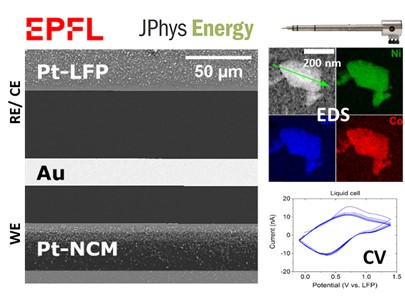Researchers led by Vasiliki Tileli’s group at École Polytechnique Fédérale de Lausanne (EPFL) have used Hummingbird Scientific liquid cell TEM holder to demonstrate the electrochemical cycling of commercial NMC-622 battery particles against delithiated LiFePO4, the latter of which is used as an actual reference electrode and is typically used in the bulk coin-cells. The work, published in Journal of Physics: Energy reports, the real-time degradation mechanism in the particles as they undergo charge/discharge cycles. The results are representative of the actual data collected in bulk cells.

The use of stable reference electrode, not based on pseudo Pt chip electrode as RE, is key to multi-cycle repeatability of the data (CV, capacity curve) presented by the authors (Figure above), and has been the core feature of our newest liquid-electrochemistry holder. The work presented here opens up a new avenue for performing realistic battery cycling in TEM with the accurate quantitative interpretation of data comparable to actual bulk cell data. The insights gained from the work can be used to better engineer electrode particles for the next-generation batteries.
Reference: Jing Hou, Anna Freiberg, Tzu-Hsien Shen, Robin Girod, Julien Gonthier, Sung-Jin Kim,
Filippo Maglia, Hubert A. Gasteiger and Vasiliki Tileli. “Charge/discharge cycling of Li1+x(Ni0.6Co0.2Mn0.2)1-xO2 primary particles performed in a liquid microcell for transmission electron microscopy studies,” Journal of Physics Energy (2020). Full Paper
View All News
